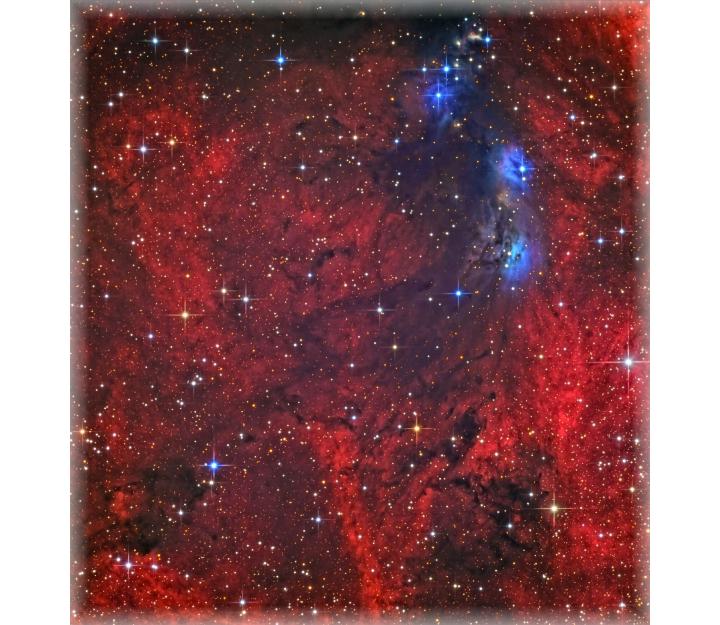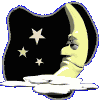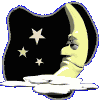 |
||
DownX2 for Asterisk.
CITSO Blog: In the Heart of the Swan
NGC 6914 in Cygnus
Imaged July and August 2012
Click the image for the high resolution version!




























NGC 6914 in Cygnus
Imaged between July 24 & August 25 2012, 15 hours total.
L=200 minutes and Ha=170 mins (both unbinned),
R=130m, G=140m, B=260m (all 2x2 binning). Subframes=10m.
Telescope=PlaneWave CDK17, Camera=Apogee U16M, Mount=Paramount ME.
Astrodon filters and MOAG, Starlight Xpress Lodestar guide camera.
Frames acquired with ACP controlling TheSky X, MaxIm DL, and Focusmax.
Processed with PixInsight and CCDInspector.
I shot this image of NGC6914 between July 24 and August 25, the first of four targets for my summer season of imaging, 2012 edition.
A brilliant blanket of red emission nebulae encompasses a intricate web of reflection nebulae of varying shades of blue, with the field shot through by stars of many vivid colours. Towards the middle of the frame the blue nebula fades gradually in colour and intensity, giving way to very dark clouds in an apparent transition that seems almost unique in the sky!
Look below for an excerpt that I've pulled from an APOD explanation of the astrophysics on display in this field of view.
I acquired a new camera at the start of the summer of 2012, the 16 Megapixel Apogee U16M, and this was my first target with it. This is a major upgrade from my previous camera, the 4 Megapixel SBIG STL-4020M. I originally got the SBIG for use with the Takahashi TOA-130 (my first serious astrograph): that camera's pixel size of 7.4 microns was well suited to the comparatively short focal length of the 5" Tak, but not for the PlaneWave CDK17. For the two years that I spent using the SBIG with the CDK17, I compensated for the undersized pixels by using the PlaneWave focal reducer to bring the system down to f/4.5 (not to mention the benefits of getting a bigger field of view!). The U16M has 9 micron pixels, and I now operate the scope at its native focal ratio of f/6.8. The big chip on the U16M has a field of view of about 3/4 of a degree! With the camera, I also acquired the Apogee 10-position filter wheel, along with a new set of filters: the Astrodon E-series LRGB and their complete set of 3-nm bandpass narrowband filters (Ha, SII, OIII, NII).
Also in summer 2012 I undertook a major upgrade of the observatory control systems by installing ACP Observatory Control Software, which now automates control of TheSkyX for the mount, MaxIm DL for the camera, and FocusMax for focuser control. With the new camera I also finally switched over to off-axis guiding (having previously used the on-camera guide chip in the SBIG STL-4020M), installing an Astrodon MOAG along with a Starlight Xpress Lodestar guide camera.
Finally, here follows the APOD explanation, incomparably clear and chock-a block with science, as with all APOD captions! Please be sure to take a look at the image that was featured in that APOD, so that you too can be blown away by the FINEST image of NGC 6914 that exists (to my knowledge - and I spent quite some time surfing). You may notice that it was taken and processed by members of the PixInsight image processing team - the PixInsight platform is a revolution in image processing sophistication and power!
"... this colorful skyscape features stars, dust, and glowing gas in NGC 6914. The complex of nebulae lies some 6,000 light-years away, toward the high-flying northern constellation Cygnus and the plane of our Milky Way Galaxy. With foreground dust clouds in silhouette, both reddish hydrogen emission nebulae and dusty blue reflection nebulae fill the 1/2 degree wide field. The view spans [about 150 light-years in my case] at the estimated distance of NGC 6914. Ultraviolet radiation from the massive, hot, young stars of the extensive Cygnus OB2 association ionize the region's atomic hydrogen gas, producing the characteristic red glow as protons and electrons recombine. Embedded Cygnus OB2 stars also provide the blue starlight strongly reflected by the dusty clouds ..."


Copyright © 2014 Howard Trottier





